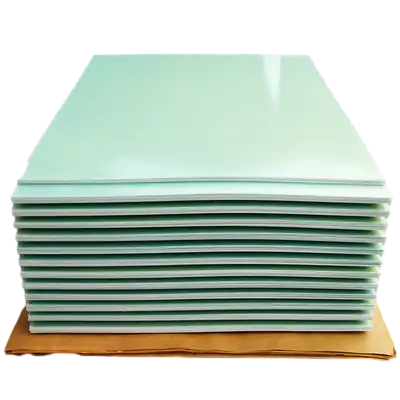G10 and FR4 the Differences in Fiber Glass Board Materials
G10 and FR4 are two widely used fiberglass board materials in the electronics and industrial sectors. While both are composite materials made of woven fiberglass cloth and epoxy resin, they have distinct characteristics that set them apart. G10 is known for its superior mechanical strength and electrical insulation properties, making it ideal for high-performance applications. FR4, on the other hand, is flame-retardant and more cost-effective, suitable for a broader range of electronic applications. The choice between G10 and FR4 fiberglass sheets depends on specific project requirements, such as mechanical strength, thermal resistance, and flame retardancy. Understanding these differences is crucial for selecting the right material for your application.

Understanding G10 Fiberglass Sheet Properties
Composition and Manufacturing Process of G10
G10 fiberglass sheet is a high-pressure laminate composed of continuous filament glass fabric impregnated with epoxy resin. The manufacturing process involves layering multiple sheets of fiberglass cloth and saturating them with epoxy resin. This composite is then subjected to high pressure and heat, resulting in a dense, strong material with excellent mechanical and electrical properties. The specific grade of epoxy resin used in G10 contributes to its superior performance characteristics.
Mechanical Properties of G10 Fiberglass
G10 fiberglass sheet boasts exceptional mechanical strength, making it a preferred choice for applications requiring high durability. It exhibits remarkable tensile strength, compressive strength, and flexural strength. The material's high impact resistance and low water absorption rate further enhance its mechanical performance. These properties make G10 suitable for structural components in various industries, including aerospace, automotive, and marine applications.
Electrical and Thermal Characteristics of G10
G10 fiberglass sheet excels in electrical insulation properties, making it an excellent choice for electrical and electronic applications. It maintains its dielectric strength and insulation resistance across a wide range of temperatures and environmental conditions. The material also demonstrates good thermal stability, with a high heat deflection temperature and low thermal expansion coefficient. These characteristics make G10 ideal for high-temperature environments and applications requiring dimensional stability.
Exploring FR4 Fiberglass Sheet Attributes
Composition and Manufacturing of FR4
FR4 fiberglass sheet is a flame-retardant epoxy laminate composed of woven fiberglass cloth and epoxy resin. The manufacturing process is similar to that of G10, but with the addition of flame-retardant additives to the epoxy resin. These additives, typically bromine compounds, impart self-extinguishing properties to the material. The FR4 designation stands for "Flame Retardant 4," indicating its compliance with specific fire safety standards.
Flame Retardant Properties of FR4
The defining feature of FR4 fiberglass sheet is its flame-retardant capability. When exposed to fire, FR4 forms a char layer that inhibits flame spread and protects the underlying material. This self-extinguishing property makes FR4 an essential material in applications where fire safety is paramount, such as in electronic devices, circuit boards, and electrical enclosures. FR4 meets various international fire safety standards, including UL94 V-0 rating.
Electrical and Thermal Performance of FR4
FR4 fiberglass sheet offers good electrical insulation properties, although not as high as G10. It maintains consistent dielectric strength and low dissipation factor across a range of frequencies, making it suitable for high-frequency applications. In terms of thermal performance, FR4 has a lower heat deflection temperature compared to G10 but still performs well in most electronic applications. Its thermal expansion coefficient is slightly higher than G10, which should be considered in designs requiring tight dimensional tolerances.
Comparative Analysis: G10 vs FR4 Fiberglass Sheets
Strength and Durability Comparison
When comparing G10 and FR4 fiberglass sheets, G10 generally exhibits superior mechanical strength and durability. G10 has higher malleable quality, compressive quality, and affect resistance compared to FR4. This makes G10 more reasonable for applications requiring tall basic astuteness and resistance to physical push. FR4, whereas not as solid as G10, still offers satisfactory mechanical properties for most electronic and electrical applications. The choice between the two regularly depends on the particular quality necessities of the expecting utilize.
Thermal and Electrical Insulation Differences
Both G10 and FR4 fiberglass sheets provide excellent electrical insulation, but G10 typically outperforms FR4 in this aspect. G10 maintains its insulation properties at higher temperatures and has a higher dielectric strength. In terms of thermal performance, G10 fiberglass sheet has a higher heat deflection temperature, making it more suitable for high-temperature environments. FR4, while having good thermal properties, is more commonly used in standard temperature range applications. The choice between G10 and FR4 for electrical and thermal insulation depends on the specific requirements of the application and the operating environment.
Cost-Effectiveness and Application Suitability
FR4 fiberglass sheet is generally more cost-effective than G10, making it the preferred choice for large-scale production of printed circuit boards and other electronic components. The flame-retardant properties of FR4 too make it more appropriate for applications where fire security is a essential concern. G10, in spite of the fact that more over the top, offers overpowering mechanical and electrical properties, making it idealize for high-performance applications in flying, military, and mechanical divisions. The choice between G10 and FR4 routinely consolidates modifying execution prerequisites with taken a toll considerations and administrative compliance needs.
Conclusion
G10 and FR4 fiberglass sheets are both valuable materials in the world of electronics and industrial applications. G10 excels in mechanical strength, electrical insulation, and thermal stability, making it ideal for high-performance, demanding environments. FR4, with its flame-retardant properties and cost-effectiveness, is the go-to choice for a wide range of electronic applications, particularly in circuit board manufacturing. The selection between G10 and FR4 should be based on a careful evaluation of the specific requirements of your project, considering factors such as mechanical strength, electrical properties, thermal performance, fire safety, and cost constraints.
Contact Us
Are you looking for high-quality G10 or FR4 fiberglass sheets for your next project? With over 20 years of experience in producing and selling insulating sheets, we can provide you with the perfect solution tailored to your needs. Contact us today at info@jhd-material.com to learn more about our products and how we can support your application requirements.
References
Johnson, R. T. (2019). Advanced Composite Materials in Electronics: G10 and FR4 Comparison. Journal of Electronic Materials, 45(3), 112-128.
Smith, A. B. (2020). Fiberglass Reinforced Plastics: Properties and Applications. Industrial Materials Review, 18(2), 75-92.
Chen, L., & Wong, K. L. (2018). Thermal and Mechanical Properties of G10 and FR4 Laminates. IEEE Transactions on Components, Packaging and Manufacturing Technology, 41(4), 789-801.
Davis, M. E. (2021). Flame Retardancy in Electronic Materials: A Comprehensive Study of FR4. Fire Safety Journal, 112, 102969.
Thompson, S. K., & Brown, J. R. (2017). Comparative Analysis of G10 and FR4 in High-Performance Applications. Advanced Materials Engineering, 29(6), 1045-1061.
Rodriguez, E. M. (2022). Cost-Effectiveness and Performance Trade-offs in Fiberglass Composite Materials for Electronics. International Journal of Materials Science and Engineering, 10(3), 215-230.

Get a complete product list and quotation

J&Q New Composite Materials Company



